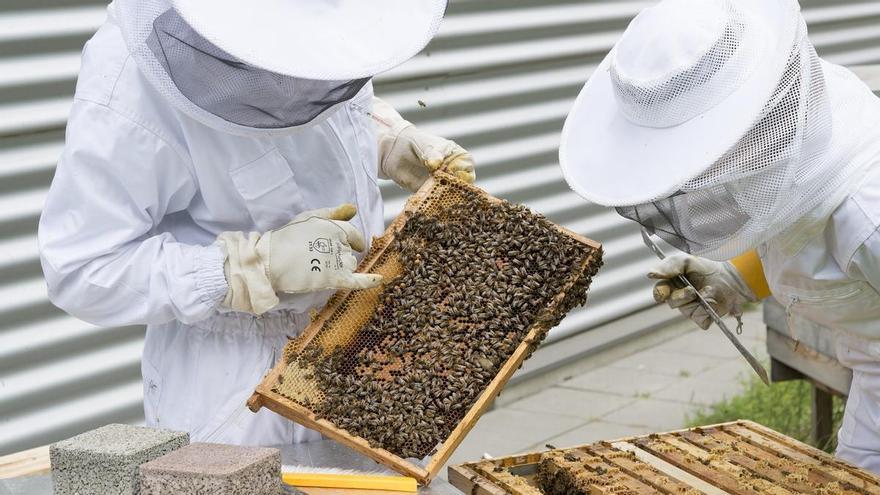
The beekeeping industry in Tenerife is on the brink of extinction. It couldn’t be clearer and harder. Last year’s forest fire was the final blow for a livestock subsector – these insects are considered livestock that is measured by the number of heads, just like any other – which was already deeply engulfed in a severe crisis due to drought, high temperatures, and the high price of feed.
The circle of life. Bees are essential for the circle of life and are at serious risk of disappearing in Tenerife, where around 600 beekeepers carry out their work, mostly as a second activity, looking after about 15,000 beehives. The numbers are declining due to various factors. Some are structural, such as the effects of climate change, persistent drought, or the high prices of feed due to inflation. This is why the County Council’s aid of 150,000 Euros is aimed at this last issue, although it is deemed “insufficient” by those affected. But on top of this, there is the detrimental impact of the major forest fire from last summer that affects the midlands and high areas of the island where most of the beekeeping operations are located. The fire that started on August 15th in the bordering hills of Arafo and Candelaria burned 1,500 and damaged between 4,500 and 5,000.
“Adding insult to injury…”. “Adding insult to injury”, evaluates Pablo Pestano, president of the Beekeepers Association of Tenerife (Apiten) when referring to the damage caused by the fire that devastated the island in a sector that was already affected by the lack of rain in recent years and consequently, the decrease in flowering, and the lack of generational succession. “We are getting worse,” Pestano summarises. He emphasizes: “We were already experiencing years of intense drought, but the fire burned many operations and the vegetation in the midlands, the Forest Crown, high areas of Arafo and Güímar, rich in chestnut trees, and even in the National Park of Teide where they say that it will take 20 to 25 years to recover the broom“. An environmental tragedy. To this we must add “the worst drought in decades with temperatures of 30 degrees in December”. He adds: “The beehives are weak and we do not have enough livestock (bees) to recover them”. He considers the County Council’s subsidy of 150,000 Euros “absolutely insufficient”, “the same amount as before the fire and in addition to the aid we received later”. But the point is, he notes, “there are no resources” and gives a stark fact: “At this time last year, we had obtained between six and seven tons of honey; now, zero, nothing at all”.
[–>
In Parliament. Francisco Linares, insular general secretary of CC and mayor of La Orotava, as well as a regional deputy, has brought up the issues facing beekeeping in the Canary Islands Parliament on several occasions. He believes that the main issues revolve around the need to import queen bees to restore the livestock and provide feed to maintain the beehives affected by burned areas in the forest fire. This is compounded by the drought and lack of flora, which is why beekeepers urgently need help. The Minister of Agriculture, Livestock, Fisheries and Food Sovereignty, Narvay Quintero, assured in this forum that affected beekeepers in Tenerife will receive assistance to restore damaged infrastructure and to purchase feed at a lower cost.
The activity. Beekeeping in Tenerife is a traditional activity that has managed to maintain its idiosyncrasy over the years. It is the island in the archipelago with the most weight in the beekeeping sector, comprising over 60% of both the beekeepers and the number of hives in total from Canary Islands. Currently, there are around 600 beekeepers on the island managing an average of 15,000 beehives.
Beekeeping practiced in Tenerife is mainly artisanal and serves as a supplement to the family income. The rugged geography of the island makes access to the beehives difficult, which are usually small in size, giving this activity a special level of difficulty and uniqueness.
The beehives used are mostly of the Langstroth or Perfection type, with traditional beehives, locally called corchos, being almost symbolic.
Issues such as the placement of beehives, coupled with the aging of the sector, challenges in commercialization through new channels, external competition, and the presence of fraud, make beekeeping in Tenerife a sector whose survival is threatened.
[–>
The development of the activity, due to the limited territory, must come, as diagnosed, through an improvement in the yields obtained from their beehives, rather than through the great expansion of the size of the operations. Promotional actions for the activity and generational turnover have led to a slight increase in the number of operations and beehives in recent years, with the incorporation of younger individuals into the sector.
World Bee Day
The Tenerife County Council commemorated World Bee Day last Monday. The Minister of Primary Sector, Valentín González, stated that “it is essential to promote awareness-raising actions with the aim of protecting these insects and the important role they play in the ecosystem”. Nearly 800 students from seven educational centres took part in the initiatives organised by the House of Honey to, according to González, “highlight the importance of preserving these pollinators and their habitat in environmental sustainability and the ecosystem, as well as supporting beekeepers”. He highlighted that “even more so this year due to the consequences of last summer’s forest fire”. A photography contest was also organised on social media called #posteaabejas, along with street marketing to interact with citizens. The County Council announced this week that it is allocating 150,000 Euros in 2024 for supplementary bee feed to counter the effects of the fire, as well as the increase in prices and energy that are putting the sector in a vulnerable position. | J.D.M.
[–>















